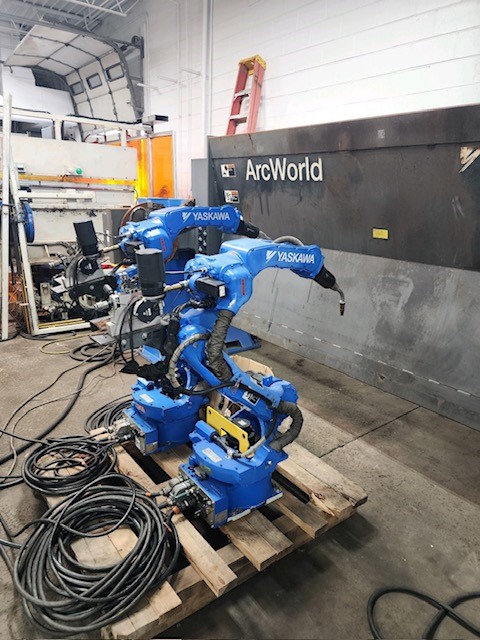Optimizing Manufacturing with Robotic Workcells

Automating production related tasks with industrial robots will significantly improve manufacturing operations. While robots on their own create more efficient operations, implementing a robotic workcell can further optimize manufacturing.
Robot workcells consist of the industrial robot arm, controller, safety devices, and other peripheral equipment that is all contained within the same workstation for a complete robotic system. There are two types of workcells, those that are pre-engineered and those that are custom built. Pre-engineered, or turnkey systems are those that are pre-built by the manufacturer. In general, all equipment and robot manipulators are already selected and integrated prior to delivery to the customer. Whereas a customized workcell is designed and built specific to the customer’s needs.
How Robotic Workcells Optimize Manufacturing
Automating productions with a robotic workcell will reduce downtime. Since workcells enclose manufacturing robot arms from workers, they can operate continuously without stoppages due to workers being near the robot work area. The FANUC M-20ia can operate around the clock within a workcell while other factory activity can also run smoothly outside the cell without interference.Not only do workcells allow for continuous robot operation but they also allow factory robots to operate to their full potential. When the Yaskawa MH50 and other articulated robots are behind barriers they can operate at their maximum speed. Robot speed is limited when workers are present but when robots are contained within workcells there are no speed limitations which allows manufacturers to maximize their operation. Longer runtimes at faster speeds will boost throughput and productivity rates.
Automating with robotic workcells reduces the safety risks workers may face when around six axis robots. Workcells enclose the robot work area with physical barriers and sensors. Workcells consist of multiple safety devices to ensure the safe operation of the robotic system. Light curtains, area scanners, pressure sensing mats, and emergency stop buttons are some of the standard safety features that are designed to monitor and stop robotic manipulator operation to prevent worker accidents and injuries.
Robotic workcells will also significantly improve part quality. Workcells allow an entire manufacturing process to be automated by robots. Eliminating human involvement prevents errors and mistakes that cause defects and poor quality. Robots are extremely accurate, ensuring all application paths are followed correctly with their high repeatability. All parts manufactured will meet the same high quality standards.
Robotic workcells can also increase manufacturing capabilities. Workcells can automate multiple processes of a manufacturing operation. When changes are needed the workcell can be reprogrammed to meet new requirements. Equipment can be added or changed as well within the workcell. Robotic workcells also allow manufacturers to scale up operations in times of high demand.
Robotic workcells will also reduce production related costs. Automating manufacturing reduces manual labor. With fewer workers there will be less salaries and benefits for companies to pay. Reducing errors and improving product quality means less waste and scrap, lowering material costs. Purchasing a pre-engineered workcell can also be more cost-effective than purchasing robotic equipment individually. A used workcell can save companies even more upfront and allow for a faster return on investment. The cost savings incurred with a robotic workcell will allow manufacturers to expand their profit margins.
Robots Done Right is the place to start when it comes to used robots. Contact us if you are interested in buying or selling a used robot.